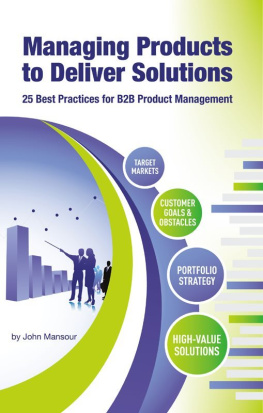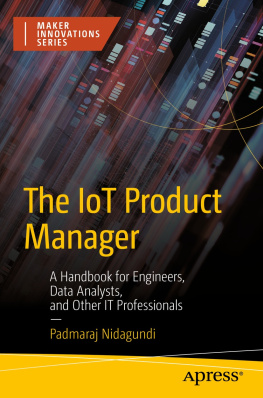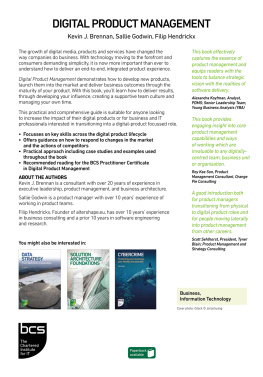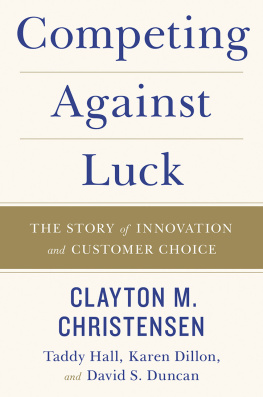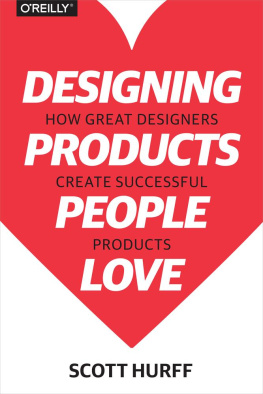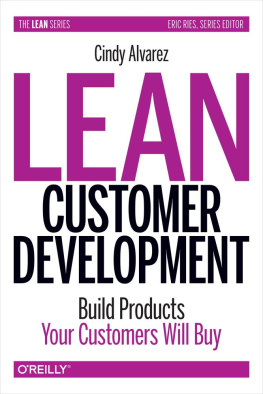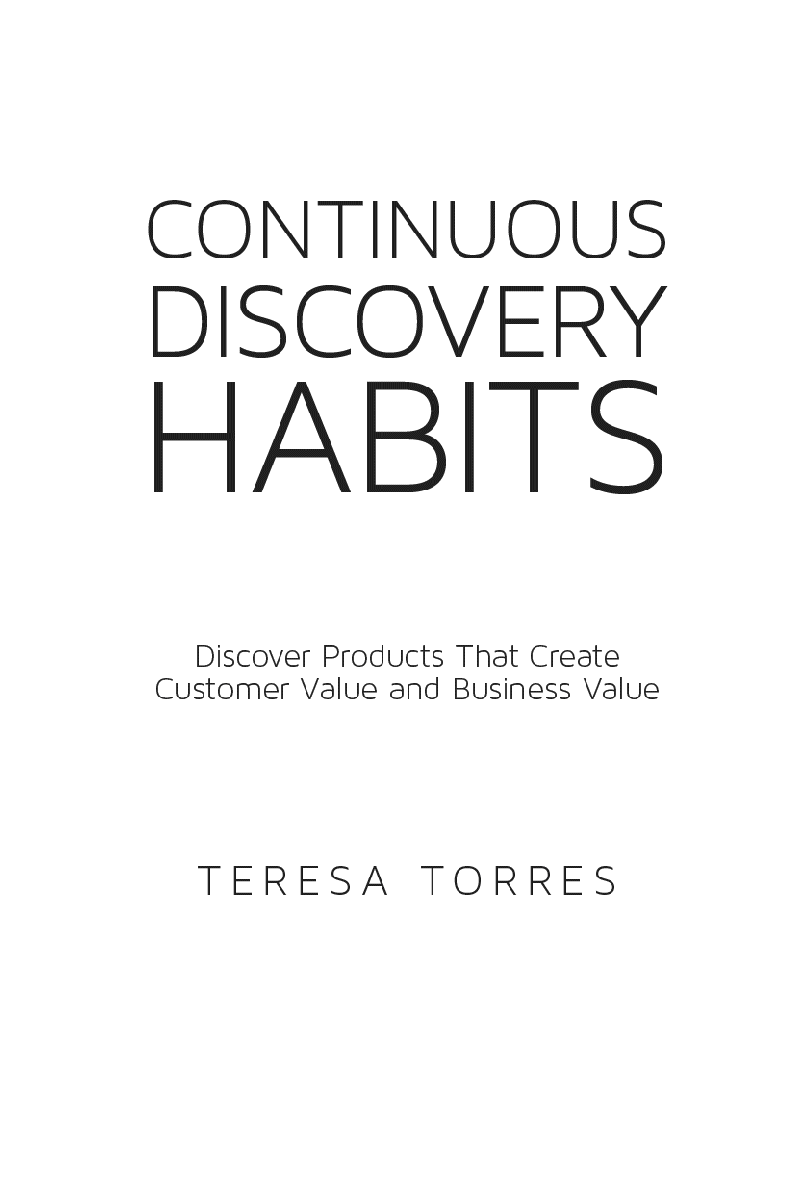Copyrighted Material
Continuous Discovery Habits: Discover Products That Create Customer Value and Business Value
Copyright 2021 by Teresa Torres. All Rights Reserved.
No part of this publication may be reproduced, stored in a retrieval system or transmitted, in any form or by any meanselectronic, mechanical, photocopying, recording or otherwisewithout prior written permission from the publisher, except for the inclusion of brief quotations in a review.
For information about this title or to order other books and/or electronic media, contact the publisher:
Publisher: Product Talk LLC, ProductTalk.org, Bend, OR 97703
Author and Illustrations: Teresa Torres
Editor: Melissa Suzuno
Cover Art: 1106 Design and Weiher Creative
Interior Design: 1106 Design
Library of Congress Control Number: 2021902811
ISBN: 978-1-7366333-0-4
Printed in the United States of America
TABLE OF CONTENTS
FOREWORD
CHRIS MERCURI
W orking in a product role is hard. There is huge pressure to solve customer problems and drive business value. Everyone is looking to you for answers. How do you come up with the right answers more often? If youre like me, youve searched all over, looking for a guide that can tell you how to do great product discovery. Most books promise a whole lotplenty of the what but little of the how. You are often left wondering what to do next.
Eventually my team and I got the opportunity to go through the Continuous Discovery Habits coaching program, which lays out the key elements of an end-to-end modern product discovery approach (the same approach youll learn in this book). The curriculum covers how to set outcomes, uncover customer problems, prioritize, come up with creative solutions, test assumptions quickly, and a lot more. What did we gain from practicing the habits, and what can you expect to gain from reading this book?
We went from chopping and changing our discovery approach and needing lots of meetings to work out what to do next to a more structured discovery process. People knew what was expected of them and delivered more consistent results.
We shifted away from a more superficial understanding of our customers. Instead of relying on heavy, infrequent research, we developed a deeper understanding of the customers needs, problems, and desires through regular contact and lightweight research methods.
We shifted away from having lists of metrics to increase and outputs to deliver. Now we have fewer goals, more clarity, and a focus on solving the customers problem in ways that drive business value.
We shifted away from falling in love with a single idea and building it. Now we come up with many ideas. And we learn faster by testing sets of ideas and running smaller simulations.
We shifted away from discovery and delivery being separate responsibilities. Now theres more collaboration, with most of the team involved in customer interviews, mapping the customer journey, ideating on solutions, and discussing results. The whole team contributes at key points along the way, and we learn and adjust our course together.
With our leaders, we no longer wait to show them big reports and presentations. Now we have the tools to show them our thinking earlier and have better conversations about where to go next.
By applying the Continuous Discovery Habits, we improved customer and business outcomes, but the reward for the team was even biggerconfidence. The habits gave us the confidence that we knew what we were doing. And after a few wins, we started to believe that we could achieve anything.
I wish that I had been introduced to the Continuous Discovery Habits much earlier in my career. If you study this book and practice the habits, product work will still be hard, and you will still make plenty of mistakes. But you will make better product decisions, and the chances that you will succeed will dramatically increase.
Chris Mercuri
Product Manager
February 2021
FOREWORD
MARTY CAGAN
A s the years go by, the more I credit luck for my good fortune, and the less I credit any particular skills I might possess.
When I was a new tech lead on a product team, I was incredibly fortunate to have an engineering manager who had a track record of consistent innovation and was truly committed to helping me develop my skills.
When I wanted to learn product management, I was assigned an experienced product leader and serial entrepreneur who coached me through the many major new areas of learning, drilled into me the principles of strong product, and made sure I knew what I needed to do along the way, and where to get help when I ran into trouble.
When I wanted to learn much more about modern product design, I had direct access to one of the best design leaders in the world, working on the leading edge of design for Internet-based products.
And when I wanted to move into product leadership, I had several world-class leaders who were willing to put in the time to coach and develop my leadership and strategy skills.
I thought constant access to that type of coaching was normal, at least until I left the bubble I was in and entered the broader technology world.
Unfortunately, as I learned and you likely already know, most people are not as lucky as I was.
Many work in organizations where the leaders have not had a chance to see how good product teams work up close. And as such, theyre unable to effectively coach and develop their people.
I meet companies like this constantly. They want to improve. They know they need to improve. They usually understand the theory of how strong teams work. But they just dont have the hands-on experience and knowledge to be able to provide the coaching their people need.
One way to address this is to bring in experienced product and technology leaders who can provide this coaching and development for their organizations. This can work very well, but many companies have found that these experienced leaders are in very high demand.
Which is why the most scalable solution I know of to this problem is to enlist the help of an experienced product coach.
This is how I first met Teresa many years ago. I saw how she had been helping product teams, and I started introducing her to many different product organizations, located all over the world. And I kept recommending her because the companies and teams she was helping were soon doing visibly better.
So when Teresa told me that she wanted to write a book sharing much of what she had learned and has been advocating at these companies, I was more than a little bit glad to hear that.
I meet so many product teams that genuinely want to do great work, but theyre just not sure what they need to do to get started solving real problems for their customers while achieving the necessary outcomes for their company.
While there is no single way for a product team to do good work, there are countless bad ways, and what so many teams need is to be coached in the right direction, much like I received when I was learning.
This book shares what Teresa has found to be most effective and will provide you with the structure you need to know what to doand whenin order to discover good opportunities and effective solutions.
My hope is that, if you havent had the good fortune to be coached by a strong leader or product coach, this book can help fill that gap and set you on the path to success.
Marty Cagan
Silicon Valley Product Group
February 2021
INTRODUCTION
I t was 2013. I was leading a product and design team at a venture-backed startup in San Francisco. We were developing a product that created real value for our customers. It was a noble causewe helped college students find their first job out of college. In our discovery, we uncovered a key insight that had the potential to disrupt our industry (more on that in ). I had a partner, our head of engineering, who was a dream to work with. We became fast friends. I was mentoring a young designer whom I had known since she was nine years oldthe daughter of a good friend of mine. I encouraged a young engineer, a recent math major from the University of Washington, to get up to speed with machine learning. I was relying on him to help us realize our product vision and was thrilled that, as a company, we were investing in young talent. I loved coming to work each day. And then one day, I walked in and quit.


